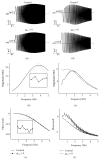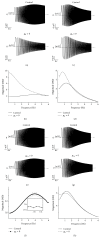Mathematical modeling of subthreshold resonant properties in pyloric dilator neurons
- PMID: 25960999
- PMCID: PMC4415491
- DOI: 10.1155/2015/135787
Mathematical modeling of subthreshold resonant properties in pyloric dilator neurons
Abstract
Various types of neurons exhibit subthreshold resonance oscillation (preferred frequency response) to fluctuating sinusoidal input currents. This phenomenon is well known to influence the synaptic plasticity and frequency of neural network oscillation. This study evaluates the resonant properties of pacemaker pyloric dilator (PD) neurons in the central pattern generator network through mathematical modeling. From the pharmacological point of view, calcium currents cannot be blocked in PD neurons without removing the calcium-dependent potassium current. Thus, the effects of calcium (I(Ca)) and calcium-dependent potassium (I(KCa)) currents on resonant properties remain unclear. By taking advantage of Hodgkin-Huxley-type model of neuron and its equivalent RLC circuit, we examine the effects of changing resting membrane potential and those ionic currents on the resonance. Results show that changing the resting membrane potential influences the amplitude and frequency of resonance so that the strength of resonance (Q-value) increases by both depolarization and hyperpolarization of the resting membrane potential. Moreover, hyperpolarization-activated inward current (I(h)) and I(Ca) (in association with I(KCa)) are dominant factors on resonant properties at hyperpolarized and depolarized potentials, respectively. Through mathematical analysis, results indicate that I h and I(KCa) affect the resonant properties of PD neurons. However, I(Ca) only has an amplifying effect on the resonance amplitude of these neurons.
Figures












References
-
- Hermann L. Beiträge zur Physiologie und Physik des Nerven. Archiv für die Gesamte Physiologie des Menschen und der Tiere. 1905;109(3-4):95–144. doi: 10.1007/bf01677961. - DOI
-
- Puil E., Meiri H., Yarom Y. Resonant behavior and frequency preferences of thalamic neurons. Journal of Neurophysiology. 1994;71(2):575–582. - PubMed
MeSH terms
Substances
LinkOut - more resources
Full Text Sources
Other Literature Sources
Miscellaneous

